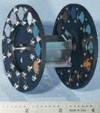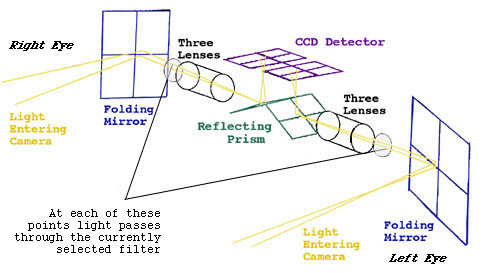
this page is still under construction. If you
have any questions or comments, click on the "send us your
questions" link at the bottom of the page.
|
The Imager for Mars Pathfinder
(IMP) and the Surface Stereo Imager (SSI) are nearly identical.
The IMP flew on the Mars Pathfinder mission, and took more than
16,000 images of the Martian surface in Ares Vallis between July
4 and September 27, 1997. The SSI will be launched in January
1999 as part of the Mars Volatiles and Climate Surveyor package,
on the Mars Polar Lander '98 mission. In late 1999 it will
land near the south pole of Mars. In this page, for convenience,
IMP images are discussed. However, the same facts apply
to SSI images.
|
 How the IMP Filters
Work
Dissecting an IMP Image | How the IMP
Records Images |
more information is available
in How the IMP Works
How the IMP Filters
Work
Dissecting an IMP Image | How the IMP
Records Images |
more information is available
in How the IMP Works |
Words in italics are defined
in our glossary, click on them to see their definition.
If a word is used repeatedly, only the first few usages are linked
to the glossary.
Anatomy: IMP Filters
 What they are and how
they work:
What they are and how
they work:
As you may have learned in "How the IMP works," the
filter wheel is one of the most important parts of the IMP.
It enables us to take many different types of images, including
color and stereo (3D) images. The filter wheel works by preventing
all but a small range of wavelengths from entering the camera.
For example, the 440 nm blue filter only lets blue light, at the
440 nanometer wavelength, pass through the filter and enter the
camera.
 In
this image, the filter wheel is shown in blue.
In
this image, the filter wheel is shown in blue.

|
In this image, we see the path of light entering the camera.
The entire filter wheel is not pictured in this diagram, but
the black lines indicate where filters (the gray circles) would
block out all light except certain wavelengths. |
Each filter is made of material that can specifically
admit only one wavelength of light. Imagine a surface filled
with many small holes. Any particles larger than the size
of the holes cannot pass beyond that surface. This is sort
of how the filters act.
The 440 nm (blue) filter blocks out most light, but blue light passes through
the 440 nm filter.
Thus, when we use the 440 nm filter, we can see which
objects in the scene are reflecting light near the 440 nm wavelength.
but blue light passes through
the 440 nm filter.
Thus, when we use the 440 nm filter, we can see which
objects in the scene are reflecting light near the 440 nm wavelength.
Types of IMP
filters:
Each of the IMP filters was included with a different
purpose in mind. Some of the filters are primarily for examining
the geology of the scene. The solar (atmosphere) filters
are dark and allow very little light to pass through, which is
practical when you are viewing a very bright object. Many
of the filters can be used for more than one thing -- for example,
the red, green and blue geology filters were used from time to
time to take color images of the sky near sunset and sunrise.
A web page about the different varieties of IMP images is currently
under construction.
Geology
Twelve of the filters in the IMP are used to examine the geology
of Mars. These filters rely on the fact that different minerals
reflect varying colors (wavelengths) of light. Some of these subtle
differences may not even be visible to the human eye, but individual
filters can be "tuned" to specific spectra (colors of
light), in order to make them very visible in the images. Geologists
have made predictions about what minerals can be found in the
area, and the filters geology filters have been picked accordingly.
Atmosphere
Eight filters are included in the camera to enabled scientists
to look at the atmosphere. Mars's atmosphere is primarily carbon
dioxide, much thinner than our own atmosphere, and extremely dusty.
The atmophere filters were used to take images of the sun.
These images are useful in determining how light interacts with
the Martian atmosphere. With these images we can investigate
many qualities of the atmosphere, including opacity, amount
of dust, size of dust particles and amount of water vapor.
Magnetic Properties
There is another filter which has to do with dust, the diopter
filter. The Danish collaborators from the Niels Bohr Institute
made some specially designed magnets, whose purpose is to collect
magnetic dust as it settles out of the atmosphere. Most
of the magnets, placed strategically on the lander, were imaged
with the normal geology filters, however, they also had their
own special filter: the diopter filter enabled the IMP to have
a high resolution view of the dust which collected on the tip
plate magnet, very close to the camera's eyes. These experiments
are interesting because dust plays such an important role in the
Martian environment
.
Stereo Capabilities
The IMP's two "eyes" are what enable scientists to
create stereo (3D) images -- that is, images which demonstrate
the depth of a scene. These images have more than entertainment
value, they make it possible to gauge distance with a technique
similar to "range finding." Differences between the
scene viewed by the right eye and the scene viewed by the left
eye can indicate the distance to objects in the scene, as well
as their distance from each other. The filters used for
stereo were geology filters. Most stereo images were
taken with the 670 nm (red) filters. Of the geology filters,
only two were able to be used for both eyes, the red and the blue
(440 nm).
| How the IMP Records Images | How
the IMP Works | Send
us your questions about the IMP |
Return to IMP
Homepage


 In
this image, the filter wheel is shown in blue.
In
this image, the filter wheel is shown in blue.
 but blue light passes through
the 440 nm filter.
but blue light passes through
the 440 nm filter.